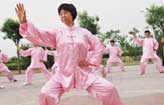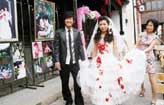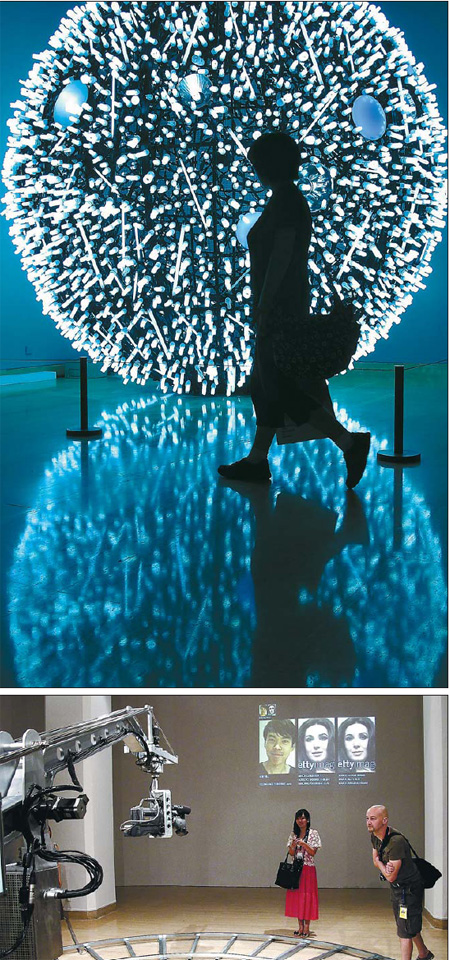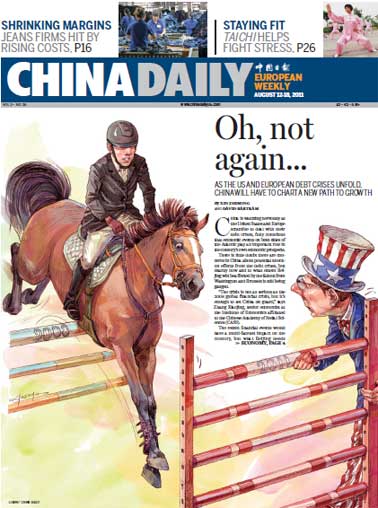Art
New media, old messages
Updated: 2011-08-17 07:54
By Zhu Linyong (China Daily)
|
Top: A visitor passes by an installation at Translife. Above: Dutch artist Marnix de Nijs' installation 15 Minutes of Biometric Fame attracts curious visitors. Photos by Jiang Dong / China Daily |
Installations at the ongoing exhibition Translife raise age-old questions such as the alienation of man and new forms of life. Zhu Linyong reports.
An ongoing exhibition at the National Art Museum, Translife, features 53 new media artworks by artists and artist groups from 23 countries and regions. Visitors can not only view the works but also interact with them at the first International Triennial of New Media Art.
"Although these works depend on digital and media technologies, they are not the usual, fancy exhibits of a pop science show. Instead, they raise questions about pressing issues facing mankind such as the ecological crisis, man's alienation and new forms of life," curator Zhang Ga says.
Zhang initiated the nation's first large-scale new media art show, Synthetic Times, a critically acclaimed 2008 Beijing Olympics Cultural Project, in collaboration with National Art Museum of China director Fan Di'an.
The triennial is a philosophically charged exhibition, Fan says.
"By engaging audiences with diverse artistic positions and strategies, the exhibition raises questions about modernity and anthropocentrism, and advocates citizen participation in confronting the current ecological and environmental crisis," he says.
The exhibition is organized in three thematically related parts. The first part is called Sensorium of the Extraordinary. Zhang says it aims to "bring awareness to otherwise imperceptible human capacities".
For instance, Dutch artist Marnix de Nijs' 15 Minutes of Biometric Fame, is an interactive installation that has a crane moving autonomously and randomly over a large circular track to point a camera at visitors in the exhibition hall.
The installation scans each visitor's facial features using biometric video analysis software and compares them to those stored in a database which features online celebrities found through searches in the world's major languages.
This is then projected on an LCD monitor. Those faces that match the ones in the database are displayed on a large public screen and added to the database - giving ordinary visitors a fleeting experience of celebrity status.
At another exhibition hall, Belgian artist Lawrence Malstaf's Nemo Observatorium gives visitors a chance to sense what being in the eye of a storm feels like, and challenges them to stay calm in a fast-changing environment. Styrofoam particles are blown around in a huge, transparent PVC cylinder by five strong fans as visitors sit on an armchair in the middle of the whirlpool.
In the chair - the eye of the "storm" - it is actually calm.
The second part of the exhibition, Sublime of the Liminal, takes artificial life, intelligent objects and transgenic hybrids as natural objects, exploring the liminal states of these emergent life forms, and their unique manifestations of vitality.
For instance, NoArk, from the Tissue Culture & Art Project, an art collective from Australia, is a display of lab-grown, lab-modified life forms, that questions ideas about a progressive complexity of species.
Meanwhile, Irish artist Ruairi Glynn's Performative Ecologies creates a kinetic "conversational" environment, "examining what it means both to observe and to be observed by machines".
Within a darkened installation space, a group of autonomous but sociable robotic sculptures perform a "dance" with their illuminated tails.
They negotiate with their audience, to attract and maintain their attention.
The third part, Zone of Impending, puts the focus on ecosystems and environments upon which all life depends, calling attention to the plight of ecological disruption.
Champs d'Ozone, an artist group from France, the United Kingdom and Germany, exploits data that measures the quality of air in Beijing, provided in quasi real time by a Weather Tunnel installed at the main entrance of the museum, and then transposes the information in a visual and sound space-time continuum.
In this device, a computer-generated cloud appears to hang over the city, saturated but always changing color, reflecting the concentrations of nitrogen dioxide, sulphur dioxide, ozone, and particle dust suspended in the air.
"Could a red cloud be more toxic than an orange one? Might there be such a thing as zero pollution? The reading of the cloud is left to the viewer to decipher," artist Helen Evans with the artist group says.
In her installation work Plant (iPod), Canadian artist Jane Tingley tries to create new relationships between human and plant life.
Her works, comprising eight plant/prosthetic objects of various shapes and sizes, are spread throughout the exhibition hall.
Each of the objects includes a built-in subwoofer with metal branches rising from it that hold two small speakers close to the leafy part of the plant, which together function as a sound system. Each object contains both sensors and speakers, so that the sound being played to the plants is directly affected by the viewer's location and proximity.
"The work evokes the possibility of developing technologies that are nature-centric rather than human-centric and reinvents the idea of the enchanted forest," Zhang, the curator, says.
To help visitors understand the exhibits better, the organizers have arranged for seminars and lectures by curators, scholars and artists, as well as on-site explanations by young volunteers who themselves are mostly media art majors, museum director Fan says.
New media art is still young in China, Fan points out.
New media art works are more complex than video or animation; and the creative process usually demands the collective efforts of artists, engineers, architects and scientists, he explains.
Of the exhibits on display, only five are from mainland artists, including two from the newly founded Art and Science Center Media Lab at Tsinghua University in Beijing.
The exhibition ends on Thursday in Beijing.
E-paper

Going with the flow
White-collar workers find a traditional exercise helps them with the frustrations of city life
The light touch
Long way to go
Outdoor success
Specials

Star journalist remembered
Friends, colleagues attended a memorial service to pay tribute to veteran reporter Li Xing in US.

Robots seen as employer-friendly
Robots are not new to industrial manufacturing. They have been in use since the 1960s.

A prosperous future
Wedding website hopes to lure chinese couples

